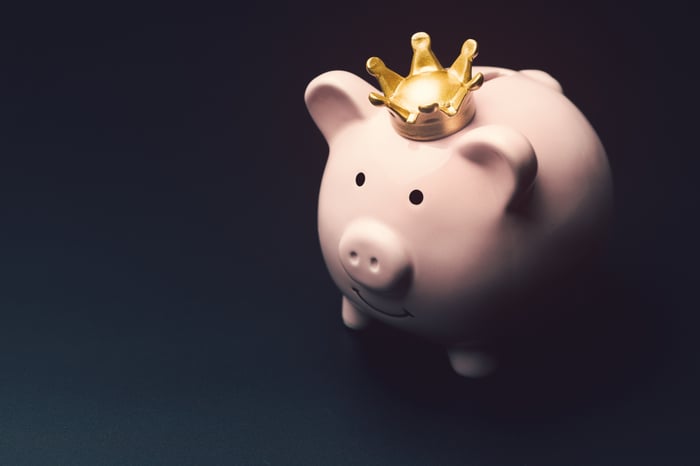In periods of rising inflation and slowing economic growth, one constant investors can count on is the reliability of dividend stocks to see them through.
The asset managers at Hartford Funds looked at the performance of the benchmark S&P 500 going all the way back to 1930 and found that dividends contributed 40% to the total return of the index over that 91-year period. The study also found that from 1960 to 2021, dividends represented an astounding 84% of the index's total return.
But which dividend stocks should you buy? In times of turmoil, I like buying stocks with long histories of not only paying dividends, but raising their payouts. For that I turn to Dividend Kings, or stocks that have increased their dividends every year for 50 years or more.

Image source: Getty Images.
These stocks have been through world wars and global pandemics, recessions and depressions, but never fail to share their success with investors. Here are five Dividend Kings I've bought to help see my portfolio through these turbulent times.
PPG Industries
Paint and coatings specialist PPG Industries (PPG -0.99%) has a long, illustrious existence. It was founded in 1883 and has paid a dividend to shareholders every year since 1899. It has raised its payout consistently for 51 years.
What makes PPG resistant to the vagaries of the market is that while a housing boom like we recently experienced provides opportunities for growth from new home sales, a downturn is still a catalyst as homeowners resort to repair and renovation. And as we saw during the pandemic, homeowners spruced up their homes because they were stuck inside.
PPG also sees the architectural coatings market as having unique growth potential, and recently partnered with Home Depot to help it expand its commercial market.
AbbVie
Even though pharmaceutical stock AbbVie (ABBV -0.30%) was only spun off from Abbott Laboratories in 2013, it is considered a Dividend King anyway because it is credited with the dividend history of its former parent, which began hiking the payout in 1972. AbbVie has continued that tradition -- increasing its quarterly payout by 270% since the company's creation. Currently, the dividend yields 3.8% annually.
Although AbbVie has long relied upon its arthritis drug Humira for the bulk of its revenue, it has a robust lineup of other drugs looking to supplement the therapy's track record while also expanding the indications for its use both here and internationally. Expect the pharma stock to keep growing for years to come.
American States Water
Utility companies were the original "widows and orphans" stocks because of their stable revenue streams. While energy competition has changed the game somewhat, American States Water (AWR -0.64%) is one of the industry stalwarts. No company has a longer record of raising its dividend than this utility charged with providing clean water and electricity to Southern California.
American States Water has regularly paid a dividend to its investors for 86 straight years, and has raised the payout each and every year for 68 consecutive years. It also has long-term contracts with the U.S. government to provide water to 11 military bases, giving it further consistency in its business.

Image source: Getty Images.
Kimberly-Clark
Arguably best-known for its Huggies diapers and Kleenex brand of tissue, Kimberly-Clark (KMB -0.98%) is a global consumer products giant with a portfolio of well-known brands essential to a quarter of the world's population. It has a foothold in 175 countries and generates over $20 billion in annual sales.
What makes Kimberly-Clark so resilient is that its products are those we use every day, meaning it constantly has customers coming back to buy more. That sort of consistency has allowed the company to raise its dividend for 50 straight years, and it has made a payment to shareholders every year since 1934.
Lowe's
Like PPG above, home improvement center Lowe's Companies (LOW -0.14%) benefits from consumer demand regardless of the direction the housing market takes. While also not completely immune from downturns, the likelihood people will shelter in place in an economic storm means they will want to brighten their digs just as much -- if not more so -- as they do when times are good. It's the sort of affordable splurge that can brighten spirits as well as the home.
Much more so than rival Home Depot, where professional contractors represent 45% of total sales, Lowe's caters more to consumers. The professional customer only accounts for a quarter of its sales. Home décor is its largest segment, with almost $8.2 billion in sales in the third quarter.
Lowe's has paid a dividend every year since going public in 1961, and it began raising the payout the very next year, giving it a 61-year record of hiking its dividend.





